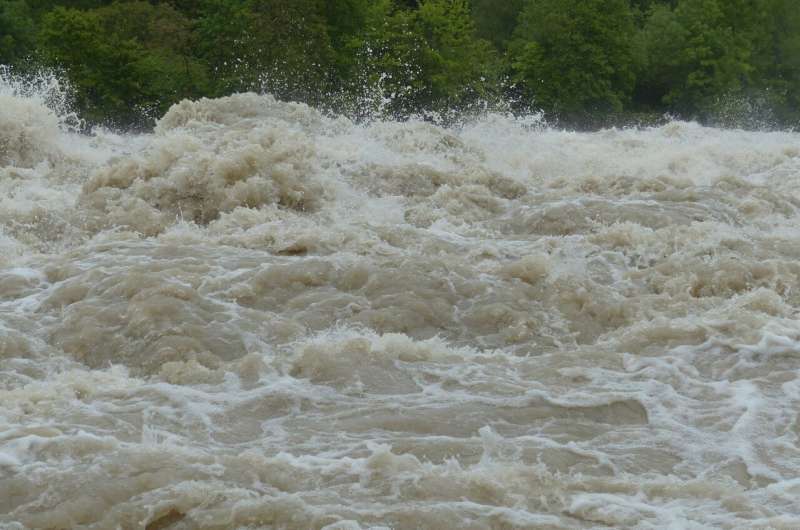This article has been reviewed according to Science X's editorial process and policies. Editors have highlighted the following attributes while ensuring the content's credibility:
fact-checked
trusted source
proofread
Researchers investigate microplastics in D.C.'s waterways

A research team from American University has spent the last three years collecting samples from several freshwater streams that feed into Washington, D.C.'s Anacostia River. They have been looking for microplastics.
These tiny plastic fragments threaten the river's quality, sediments and aquatic life. Their goal: To help government officials regulate the use and disposal of plastics, including single-use plastics, a major culprit behind microplastics. Their first findings from the Nash Run stream have just been published and tell us more about what's going on with microplastics in D.C.'s waterways.
"There are very few published research studies about the abundance and type of microplastics found in waterways in the D.C. region," said Barbara Balestra, senior professorial lecturer in the Department of Environmental Science in the College of Arts and Sciences. "This paper is a comprehensive analysis of our sampling at Nash Run.
It reveals the quantity and type of microplastics in water and sediments." Balestra's former student, Elisa Davey, participated in the research and is lead author for the paper published in the journal Water, Air, Soil Pollution. Many students at AU are involved in pollution and water research.
Nash Run, which flows through the neighborhoods of Deanwood and Kenilworth in Southeast D.C., is one of a half-dozen sites of river tributaries in D.C. and in Maryland that the team samples for microplastics. They always find microplastics, no matter the season or sample site. In water samples collected along different points of Nash Run, the team found a range of 24 to 127 microplastic particles per liter.
Is this amount a lot? It's hard to say. Microplastics make up many kinds of plastics and range from the nano to millimeter size. Experts agree there is a need to create standardized methods for microplastics testing to better assess impacts. For now, scientists across the world are finding wide ranges of particles when they measure.
In Nash Run, the team's chemical analysis shows the main type of microplastic as HDPE, or high-density polyethylene, commonly used in making containers for milk, motor oil, shampoos and conditioners, soap bottles, detergents and bleaches.
Microplastics are remnants of large plastics broken up into smaller pieces, or products such as microbeads that are found in many cosmetics. They are found in freshwater and oceans and animals, such as clams, oysters and fish. They have been found in humans, as evidenced by studies showing them in our lungs or in the placentas of newborns.
Despite what we know, there is still so much we don't know. Many studies are underway to assess the health risks to humans and animals posed by microplastics. Because of their size, they can't be easily removed from waterways. Businesses and governments are responding to the problem with sustainability goals to end the use of single-use plastic, and with plastic bag bans or prohibitions on businesses from providing single-use plastics and cutlery in dining orders.
Fighting pollution in D.C's Anacostia River
Improving the health of D.C.'s Anacostia River has been a focus of governments and nonprofits for many years. Stephen MacAvoy, associate professor of environmental science and a paper co-author, researches naturally occurring contaminants and human-derived pollutants that affect freshwater and its animals. MacAvoy and his students examine the river's geochemistry, try to determine causes for the odd chemistry they observe, and look for signs of change as efforts to improve the river's water quality move forward.
"For me, the takeaway from the research is this: Here's yet another challenge that these animals may face in this river. We make strides in improving the river's health; then there are setbacks," MacAvoy said.In addition to microplastics, researchers detected another pollutant in the sediment, three chemicals, phenanthrene, fluoranthene and pyrene, also known as PAHs. More research will need to be conducted to assess the sources of these chemicals.
Many studies on microplastics show how microplastics interfere with animal life; other studies show how animals such as mussels consume microplastics, thereby suggesting that some animals may help in mitigation.
"With microplastics we tend to talk a lot about the ocean. We've overlooked freshwater systems. We don't know the harms, so we need to continue to monitor the tributaries, the sediment and the river itself," said MacAvoy. "We need to understand what happens to a mussel if it's eating, or filtering, large amounts of plastic daily."
In the meantime the team is launching new sample projects directly at the river and also the Potomac watershed, and connecting with others working on microplastics in the region to share knowledge.
"The Nash Run research helps with beginning to build a baseline for the D.C. area and microplastics pollution," Balestra said. "Comparing the different samples and sites, we will learn about microplastics distribution on a large scale and inform policymakers about this pollutant."
More information: Elisa Davey et al, Microplastics and Polycyclic Aromatic Hydrocarbons: Abundance, Distribution, and Chemical Analyses in the Nash Run, an Urban Tributary to the Anacostia River (Washington, DC, USA), Water, Air, & Soil Pollution (2023). DOI: 10.1007/s11270-023-06468-5
Provided by American University




















